 Though a tulip may seem to be just another flower we see at the flower shop, the story of the tulip is actually a fascinating one, full of tales of thievery, broken hearts, and great fortune.
Though a tulip may seem to be just another flower we see at the flower shop, the story of the tulip is actually a fascinating one, full of tales of thievery, broken hearts, and great fortune.
 It is widely believed that tulips come from Holland, but this is not exactly true. Tulips were originally a wild flower growing in Central Asia, first cultivated as early as the year 1,000 AD by people in the Ottoman Empire (present-day Turkey.) In fact, the name "tulip"" comes from the Turkish word for turban."
It is widely believed that tulips come from Holland, but this is not exactly true. Tulips were originally a wild flower growing in Central Asia, first cultivated as early as the year 1,000 AD by people in the Ottoman Empire (present-day Turkey.) In fact, the name "tulip"" comes from the Turkish word for turban."
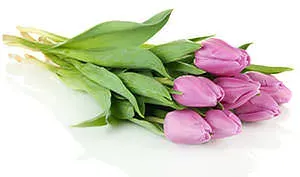 The first occurrence of "tulip-mania"" occurred in Turkey in the 1500's. The gorgeous, colorful flowers were grown specifically for the Sultan Suleiman and his entourage, and were a source of the peoples' admiration."
The first occurrence of "tulip-mania"" occurred in Turkey in the 1500's. The gorgeous, colorful flowers were grown specifically for the Sultan Suleiman and his entourage, and were a source of the peoples' admiration."
 Between 1703-1730, the tulip was the supreme symbol of wealth, and that period of time later became known as the "Age of the Tulips."" The Turks began enforcing strict laws governing the cultivation and sale of the flowers. Buying or selling tulips outside the capital of Turkey became illegal and punishable by exile."
Between 1703-1730, the tulip was the supreme symbol of wealth, and that period of time later became known as the "Age of the Tulips."" The Turks began enforcing strict laws governing the cultivation and sale of the flowers. Buying or selling tulips outside the capital of Turkey became illegal and punishable by exile."
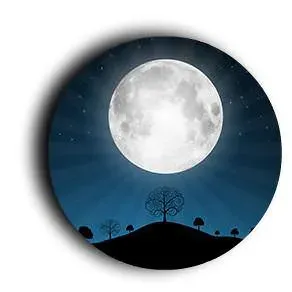 In the early 1700's, the first of the now famous tulip festivals was started by the Turkish people- held at night during a full moon. Hundreds of beautiful vases were filled with the most beautiful specimen of tulips available, and crystal lanterns were used to cast enchanting light over the gardens while birds sang for the guests. Guests were even required to wear colors that would match the exquisite colors of the flowers. It was a sight to see!
In the early 1700's, the first of the now famous tulip festivals was started by the Turkish people- held at night during a full moon. Hundreds of beautiful vases were filled with the most beautiful specimen of tulips available, and crystal lanterns were used to cast enchanting light over the gardens while birds sang for the guests. Guests were even required to wear colors that would match the exquisite colors of the flowers. It was a sight to see!
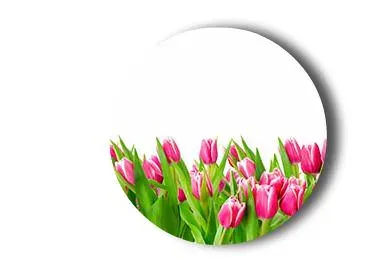 In the 16th Century, Carolus Clusius, a famous biologist from Vienna became the director of the oldest botanical garden in Europe. Clusius was hired by the University of Leiden to research tulips as medicinal plants. It was then that he got ahold of some bulbs of tulips from the ambassador of Constantinople (now Istanbul). Clusius planted the bulbs and this was the start of the beautiful tulip fields we see today. Clusius introduced the beautiful, colorful flowers to Western Europe and the Netherlands in the 1590's. He also wrote a book about the flowers in 1592, and tulips then gained immense popularity. Clusius however, was a selfish gardener and refused to sell or share the flowers with anyone, despite generous offers from many people. Clusius' selfishness lead to many robberies of his gardens. Clusius then became so fed up with the robberies, that he stopped growing the flowers and gave up on any dealings with tulips whatsoever.
In the 16th Century, Carolus Clusius, a famous biologist from Vienna became the director of the oldest botanical garden in Europe. Clusius was hired by the University of Leiden to research tulips as medicinal plants. It was then that he got ahold of some bulbs of tulips from the ambassador of Constantinople (now Istanbul). Clusius planted the bulbs and this was the start of the beautiful tulip fields we see today. Clusius introduced the beautiful, colorful flowers to Western Europe and the Netherlands in the 1590's. He also wrote a book about the flowers in 1592, and tulips then gained immense popularity. Clusius however, was a selfish gardener and refused to sell or share the flowers with anyone, despite generous offers from many people. Clusius' selfishness lead to many robberies of his gardens. Clusius then became so fed up with the robberies, that he stopped growing the flowers and gave up on any dealings with tulips whatsoever.
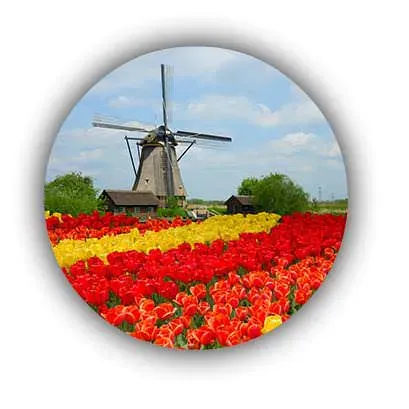 Instead of being used for medical reasons, as per the original plan, tulips started to be widely used as beautiful garden decorations. They were also seen in many paintings, and festivals. The flowers became a hugely popular trading product in the Netherlands. Tulip bulbs thus demanded high prices. Botanists also began finding ways of making tulips even more beautiful and these mutations were even more expensive and a sign of even higher status for anyone who owned them. Tulips were found in the gardens of every Emperor, King, Prince, Archbishop, or member of the aristocracy. Mirrors were often placed in these people's gardens to give the illusion that even more tulips were planted.
Instead of being used for medical reasons, as per the original plan, tulips started to be widely used as beautiful garden decorations. They were also seen in many paintings, and festivals. The flowers became a hugely popular trading product in the Netherlands. Tulip bulbs thus demanded high prices. Botanists also began finding ways of making tulips even more beautiful and these mutations were even more expensive and a sign of even higher status for anyone who owned them. Tulips were found in the gardens of every Emperor, King, Prince, Archbishop, or member of the aristocracy. Mirrors were often placed in these people's gardens to give the illusion that even more tulips were planted.
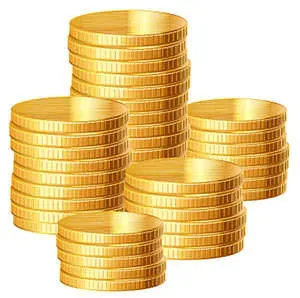 Between 1636 and 1637 the Netherlands experienced "tulip mania"" where unbelievably, some tulips cost more than buying a house at the time! The lower class population could not afford the beautiful flowers, so they settled for anything that had to do with tulips- art, furniture, embroideries and ceramics featuring tulips became extremely popular. Paintings of tulips which were made for tulip catalogues at the time, are now considered works of art. The tulips featured in these paintings were the most expensive kind- the flowers with ""broken"" color."
Between 1636 and 1637 the Netherlands experienced "tulip mania"" where unbelievably, some tulips cost more than buying a house at the time! The lower class population could not afford the beautiful flowers, so they settled for anything that had to do with tulips- art, furniture, embroideries and ceramics featuring tulips became extremely popular. Paintings of tulips which were made for tulip catalogues at the time, are now considered works of art. The tulips featured in these paintings were the most expensive kind- the flowers with ""broken"" color."
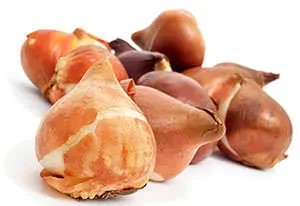 Tulip bulbs began to be sold by weight while they were still in the ground. This business was known as "the wind trade."" The business was so popular that lower class people began selling their homes, farm animals and businesses to be able to buy the bulbs, as this was such a lucrative, no-risk way to make money from the upper class. Eventually because of this, tulips stopped being such a rare commodity, so prices fell, dealers went bankrupt, and many people tragically lost their savings. This period of time, in 1637, is referred to as ""the tulip crash"" and as such, the government introduced special trading restrictions for the flowers."
Tulip bulbs began to be sold by weight while they were still in the ground. This business was known as "the wind trade."" The business was so popular that lower class people began selling their homes, farm animals and businesses to be able to buy the bulbs, as this was such a lucrative, no-risk way to make money from the upper class. Eventually because of this, tulips stopped being such a rare commodity, so prices fell, dealers went bankrupt, and many people tragically lost their savings. This period of time, in 1637, is referred to as ""the tulip crash"" and as such, the government introduced special trading restrictions for the flowers."
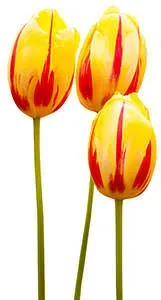 Tulips come in their natural state- a solid color, or in the hybrid form- with frilly petals and dramatic flames of colors. In the 20th Century, it was discovered that the hybrids were symptoms of an infection caused by a louse that lived on peaches and potatoes. These varieties are not sold anymore. When you see versions of tulips that look like this, they are similar in appearance to the old kind, but are now genetically stable.
Tulips come in their natural state- a solid color, or in the hybrid form- with frilly petals and dramatic flames of colors. In the 20th Century, it was discovered that the hybrids were symptoms of an infection caused by a louse that lived on peaches and potatoes. These varieties are not sold anymore. When you see versions of tulips that look like this, they are similar in appearance to the old kind, but are now genetically stable.
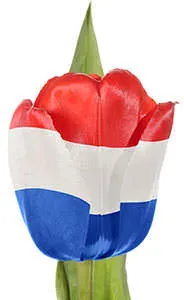 Today, Holland is still known for their tulips and the country is referred to as "the flower shop of the world."" The Dutch now export 1.2 billion tulip bulbs a year. There are still tulip festivals in Holland and you can find great fields of tulips in beautiful colors all over the country in the springtime. Holland's tulip festivals are held from late April to early May in the middle of these tulip fields. The world's biggest flower auction takes place in Aalsmeer, near Amsterdam. Entry tickets to Tulip festivals are often included in tourists' travel packages in Holland as the festivals are so well known."
Today, Holland is still known for their tulips and the country is referred to as "the flower shop of the world."" The Dutch now export 1.2 billion tulip bulbs a year. There are still tulip festivals in Holland and you can find great fields of tulips in beautiful colors all over the country in the springtime. Holland's tulip festivals are held from late April to early May in the middle of these tulip fields. The world's biggest flower auction takes place in Aalsmeer, near Amsterdam. Entry tickets to Tulip festivals are often included in tourists' travel packages in Holland as the festivals are so well known."
 Tulip festivals, thanks to the Dutch who took their love of tulips abroad, now also take place in New York and Michigan. Dutch migrants who settled in new homes all over the world also brought tulips to Silvan in the gorgeous Dandenong Ranges of Victoria, Australia, where tulips also are abundant.
Tulip festivals, thanks to the Dutch who took their love of tulips abroad, now also take place in New York and Michigan. Dutch migrants who settled in new homes all over the world also brought tulips to Silvan in the gorgeous Dandenong Ranges of Victoria, Australia, where tulips also are abundant.